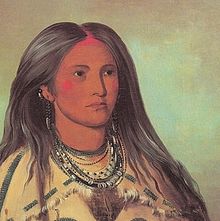
Back ماندان Arabic Мандан Byelorussian Mandans Catalan Tsé-heše'émâheónese CHY Mandan Welsh Mandan (indfødte amerikanere) Danish Mandan (Volk) German Mandan Spanish Mandanid Estonian Mandanit Finnish
 Portrait of Sha-kó-ka, a Mandan girl, by George Catlin, 1832 | |
| Total population | |
|---|---|
| 1,171 (2010)[1] | |
| Regions with significant populations | |
| Languages | |
| English • Hidatsa • formerly Mandan | |
| Related ethnic groups | |
| Hidatsa, Arikara |
The Mandan are a Native American tribe of the Great Plains who have lived for centuries primarily in what is now North Dakota. They are enrolled in the Three Affiliated Tribes of the Fort Berthold Reservation. About half of the Mandan still reside in the area of the reservation; the rest reside around the United States and in Canada.
The Mandan historically lived along both banks of the Upper Missouri River and two of its tributaries—the Heart and Knife rivers—in present-day North and South Dakota. Speakers of Mandan, a Siouan language, they developed a settled, agrarian culture. They established permanent villages featuring large, round, earth lodges, some 40 feet (12 m) in diameter, surrounding a central plaza. Matrilineal families lived in the lodges. The Mandan were a great trading nation, trading especially their large corn surpluses with other tribes in exchange for bison meat and fat. Food was the primary item, but they also traded for horses, guns, and other trade goods.
- ^ "2010 Census CPH-T-6. American Indian and Alaska Native Tribes in the United States and Puerto Rico: 2010" (PDF). www.census.gov. Retrieved 18 January 2015.